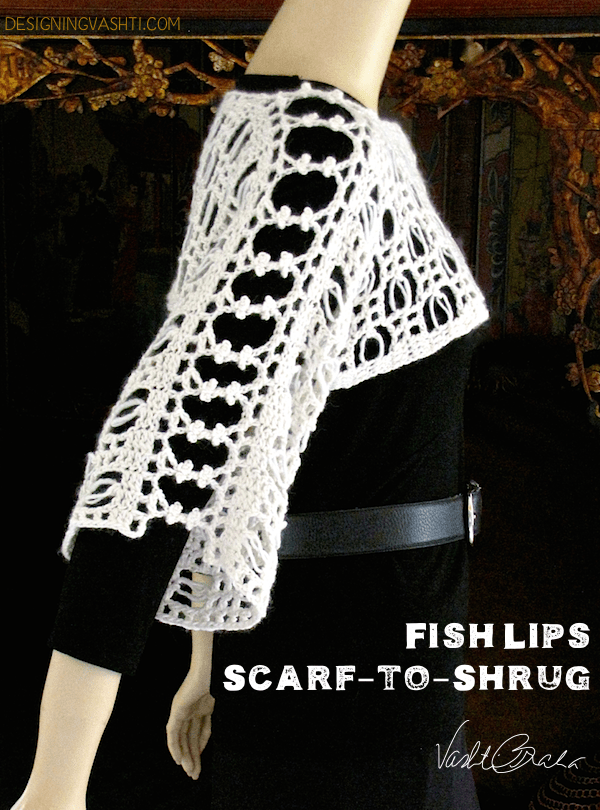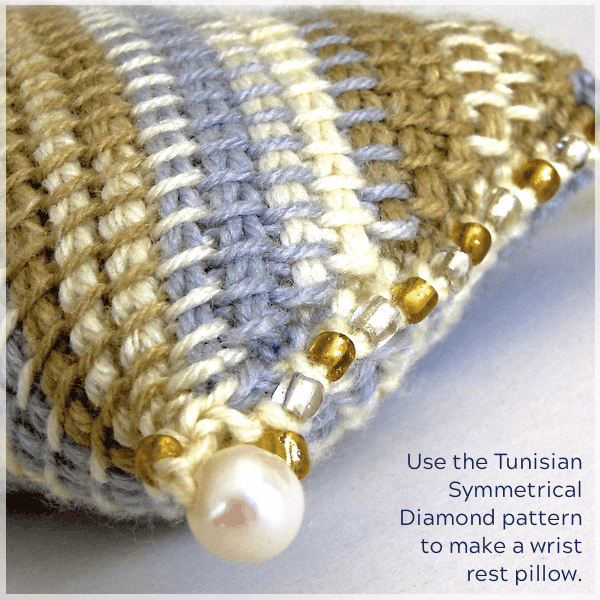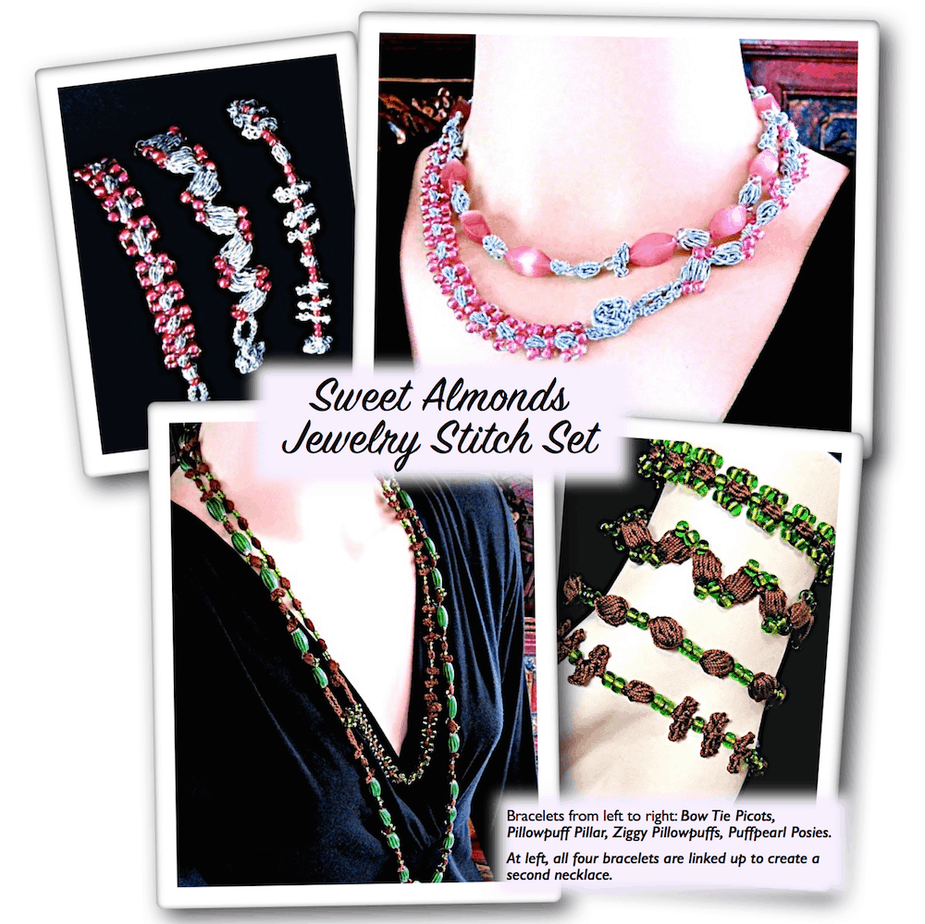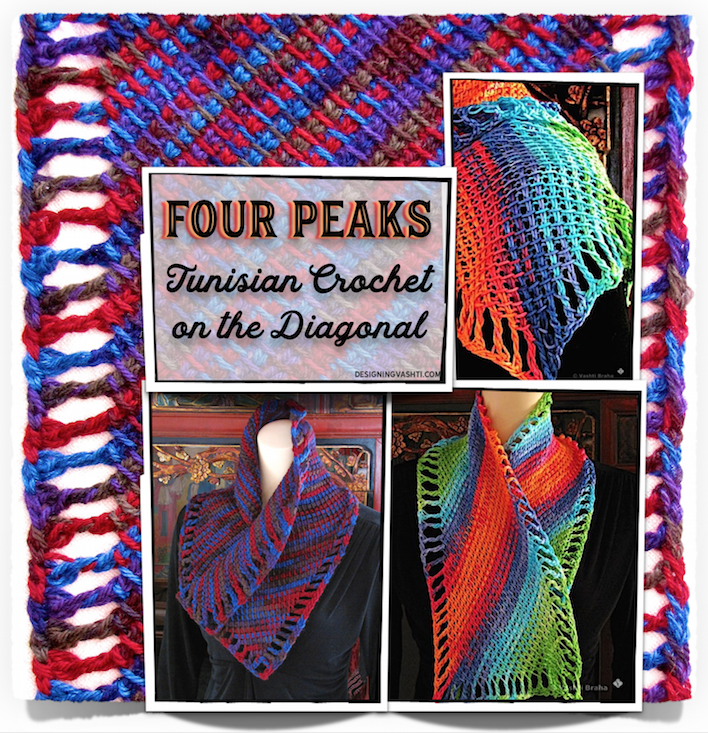
Fish Lips brings out the bold, modern side of Love Knot stitches (a.k.a. Lover’s Knot, Solomon’s Knot) for a trendy pullover shrug. The shrug is created by joining two simple shapes—scarves—with a lacy seam. The wide seam also modifies the bateau neckline for a comfortable fit.
It’s also a scalable method for adding freeform love knots anywhere: I’ve been using it to sculpt the size and shape of Love Knots. I developed the method while exploring new material for my 21st Century Love Knot Adventures crochet classes.
Crocheters with more experience can use the scalable method to substitute any yarn, thread, or hook size. Once you know how to scale the size of Love Knots yourself, it’s easier to add them anywhere, and “sculpt” their shape in a freeform manner.
The stitch pattern is fast and easy to memorize. A finished edge (selvedge) is built in to stabilize the “fish lips.” Stitch pattern multiples, a stitch diagram, schematics, and other information for customizing the width and height of your rows are included. I’ve also included some yarn and swatch talk, because different yarns add their own effects to Love Knots.
Skill Level
Advanced Intermediate due to the scalable approach to making Love Knots. Complete, in-depth, tested information on how to crochet it for all skill levels is provided.
View all of our love knot patterns here.
Included: international English equivalents for American terms.
?After using this pattern, you will know (if you didn’t already):
- How to crochet a standard Love Knot Stitch (a.k.a. Solomon’s Knot, Lover’s Knot).
- How to customize the size and shape of your Love Knots.
- How to add Love Knots of any size anywhere in a crochet pattern for unique lacy effects.
- How to crochet two scarves together with a decorative Rosebud Bridge seam.
- How to construct a pullover shrug with a scarf pattern.
Finished Dimensions
Pattern includes options for customizing the dimensions, and information for using thicker or thinner yarns with the Fish Lips stitch pattern.
Fish Lips Lace Scarf: 60″ X 7-7.25″ wide {152.4 cm X 17.75-18.4 cm}.
Shrug Option: One size fits Small to Large (see schematic, p. 8).
- Head opening: 12.5″ {31.5 cm}.
- Bust: 42″ {106.7 cm}. Designed for roomy fit. Easy to adjust during seaming.
- Sleeve opening: 8″ {20.3 cm}. Bust opening/hem adds extra ease to armhole drop.
- Sleeve length (adjustable) from shoulder point to cuff: 15″ {38 cm}.
Materials
- Crochet Hook: Size US-8/H/5 mm and US-7/G/4.5 mm crochet hook. Smaller hook is used for the shoulder seam of the shrug.
- A spray bottle filled with fresh water. A tiny travel size is great to have on hand for the first few rows while you are establishing the scale of your Love Knots.
- Yarn Shown: The Alpaca Yarn Company Astral (50% Tencel, 30% Alpaca, 20% Wool; 197yds/180m per 3.5oz/100g) color 8100 cream. For scarf, .75 skein; for Shrug, 1.5 skeins.
Substituting a yarn: Look for a Standard Medium Weight #4 Yarn that has some bounce, and that is at least 50% natural fiber so that damp blocking will bring out some drape. (Steam blocking, such as for “killing” acrylic to create drape, is not recommended for this pattern because it could cause the “fish lips” to collapse.) This yarn weight usually pairs well with a hook size in the range of US7/G/4.5mm to US9/I/5.5mm. These yarns may also be referred to as DK (Double Knitting), Light Worsted, or Worsted weight.



